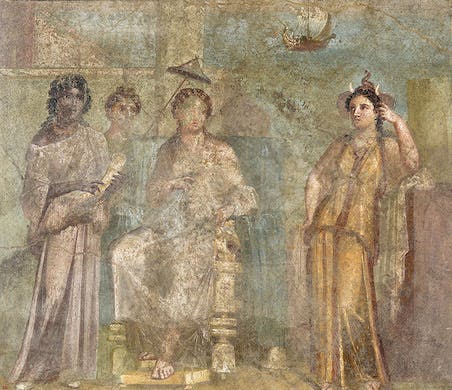Pompeii, Doomed Metropolis, Comes Alive, and in Glorious Color, Through a Portal on East 84th Street
These frescoes disclose the love affair of Rome with Athens, and the overwhelming influence of Greek culture on the imagination of the elites whose homes were adorned with them.

Step into a stately townhouse on East 84th Street on Manhattan’s Upper East Side, and you’ll quickly find yourself transported to an extinct city on Italy’s Mediterranean coast, nestled at the base of a volcano. Like Troy and Mohenjo-daro, Pompeii is an absent presence in the history of civilization.
“Pompeii in Color,” curated by Clare Fitzgerald and open until May 29 at New York University’s Institute for the Study of the Ancient World, is a portal to that doomed metropolis, which in year 79 of the common era was stilled by an eruption of Mount Vesuvius. Many of these works usually reside at the National Archaeological Museum of Naples, but have traveled to New York as ambassadors from a vanished place.
Pompeii was preserved by the ash that smothered its inhabitants, though historians now believe that most residents had time to escape. The works of art that make “Pompeii” so compelling are also survivors, mute witnesses to a vanished world.
These paintings also remind the viewer of the richness of ancient art, embedded as it was in a world steeped in myth and symbolism that stretched all the way back to Homer, and beyond. There is nothing ghostly about these frescoes, however. They are full bodied and vibrant, saucy art that would have been a part of home decor.
“Pompeii” brings together more than 80 paintings spread over two large rooms, but those looking for reference to Caesar and Mark Antony will be disappointed. Instead, these frescoes disclose the love affair of Rome with Athens, and the overwhelming influence of Greek culture on the imagination of the elites whose homes were adorned with them.
As the Latin poet Horace put it: “Graecia capta ferum victorem cepit et artes intulit agresti Latio” — “Conquered Greece took captive her savage conqueror and brought her arts into rustic Latium.” What a glorious captivity it was, though, highlighted by the show-stopping “Hercules and Omphale,” salvaged from the house of one Marcus Lucretius, with the great hero staggering from drink against an azure sky.
Another painting, “Dido Abandoned by Aeneas,” is sourced from Virgil’s “Aeneid,” the epic of the Roman Empire written in imitation of Homer’s “Iliad” and “Odyssey.” The women in the fresco feel like they could step out of it, their postures and criss-crossing gazes telegraphing crisis and consternation against the departing ship in the background. We linger with the Carthiginian queen left behind.
Two paintings of “Achilles on the Island of Skyros,” by different artists but sharing a subject, depict the áristos Akhaiôn — “best of the Greeks” who fought in the Trojan War — being discovered incognito on an isle of women, where he had been hidden from danger by his mother to prevent him being drafted into battle. The frescoes capture the tumult and drama of discovery, the moment when Achilles’s life changed forever.
A less narrative but intensely striking work is “Mask Amid Bunches of Grapes and Vines,” which centers on a woman’s head lost in a sea of grape clusters and leaves, a disembodied visage that is hard to look away from. It is easy to read as an allegory for the lost and affluent city, stilled by nature and preserved in art and culture. There is something almost modern about “Mask,” collagelike and experimental.
“Venus and Mars” features the two deities in a scene both domestic and dreamlike, with the god of war, bronzed and dark from the heat of battle, reaching for the goddess of love in a posture that highlights the bold sensuality that backlights many of these frescoes. A sharply drawn servant works on the left, looking away from the divine couple while also testifying to a world where the supernatural was close at hand.
A cluster of still lives highlights the range of genres “Pompeii” offers. I was struck by these images of fish, fruit, and parchment, and their suggestion of well-stocked pantries, generously provisioned dinner parties, and studies rich in books and learning. The Roman mind might have gravitated toward the gods, but days are lived among objects of use and pleasure. Still, these paintings reminded me, there is life.

